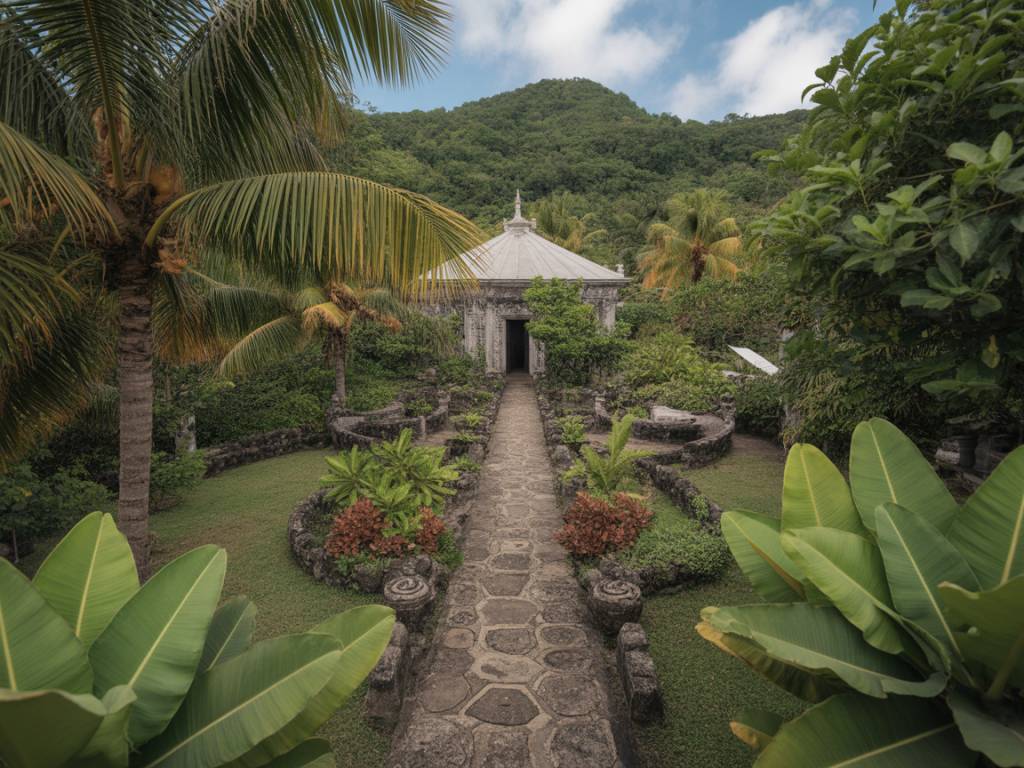Discovering the Beauty of Creole Gardens in Martinique
Martinique, a pearl of the French West Indies, offers a wealth of natural and cultural treasures. Among its most authentic and vibrant expressions is the Creole garden, known locally as « jardin créole. » These gardens embody centuries of tradition, ecological wisdom, and artistry passed down from generation to generation. They tell stories—not only of plants and landscapes, but also of the Caribbean way of life, where healing, sustenance, and aesthetics are harmoniously interlinked.
More than just cultivated spaces, Creole gardens in Martinique are an integral part of the island’s identity and heritage. They reflect resilience, resourcefulness, and the strong connection between the people and their environment. In this article, we delve into the most beautiful Creole gardens of Martinique, exploring their traditional structure, medicinal plants, and unique lifestyle they preserve.
The Origins and Role of Creole Gardens in Martinique
The concept of Creole gardens dates back to the era of slavery and colonial plantations. Enslaved Africans, forcibly brought to the Caribbean, used the land allotted to them to grow food crops and medicinal herbs. These gardens were born out of necessity, but evolved into a deep-rooted tradition that combines African, Caribbean, and European botanical knowledge.
Today, Creole gardens serve as a practical and aesthetic facet of everyday life in Martinique. Found in both rural and suburban areas, they are typically cultivated adjacent to homes and feature a mix of fruit trees, vegetables, herbs, medicinal plants, and ornamental species. Their multifunctional nature supports self-sufficiency, biodiversity, and well-being.
Visiting the Most Beautiful Creole Gardens in Martinique
For visitors eager to explore these lush spaces, several public and private gardens open their gates to showcase authentic Creole gardening. These locations also serve as centers for education on agroecological practices and traditional medicine.
- Habitation Clément – Le François: While known primarily for its rum distillery, the estate includes an expansive Creole garden filled with medicinal and aromatic plants, centuries-old trees, and a landscaped botanical trail.
- Jardin de Balata – Fort-de-France: Though more ornamental in nature, the Jardin de Balata exhibits elements of the Creole style with a mix of tropical flora, hummingbirds, and shaded paths, reflecting the integration of nature into daily life.
- Ferme Perrine – Le Lamentin: A sustainable farm that offers a window into the diversity of crops grown in Martinique, including many traditional plants found in home gardens across the island.
Each garden is unique but holds common traits: a diversity of functions, a harmony between useful and aesthetic plants, and the use of environmentally friendly cultivation practices. They are peaceful places to wander and also to understand the ties between culture, cuisine, and ecology in Martinique.
Key Plants in Martinique’s Creole Gardens
One of the most fascinating aspects of Creole gardens lies in their biodiversity. The careful combination of plant species is not accidental but follows experiential knowledge rooted in centuries of observation and adaptation to the tropical climate.
Here are some of the most common and cherished plants you may encounter:
- Ginger (Zingiber officinale): Widely used for cooking and treating colds, nausea, and digestive issues.
- Aloe Vera: A classic medicinal plant for skin irrigation, burns, and internal detoxification.
- Noni (Morinda citrifolia): Revered for its potential antioxidant and pain-relief properties.
- Soursop (Graviola): A fruit tree producing a delicious and medicinal fruit believed to support immune health.
- Thym-pays (Tropical Thyme): A key ingredient in Creole cooking and herbal infusions against flu and fevers.
Plants in a Creole garden are rarely planted in monocultures. Instead, gardeners mimic the layered structure of a tropical forest, allowing plants to support each other’s growth and repel pests more naturally. This arrangement ensures a resilient and productive ecosystem within a small space.
Medicinal Traditions Passed Down Through Generations
In Martinique, as elsewhere in the Caribbean, traditional medicine plays a critical role in everyday health. Home remedies made from garden-grown herbs have long been the first line of defense against common ailments.
The practice of “rimèd razié,” or herbal medicine, relies heavily on the deep knowledge of local elders, especially women, who are considered custodians of this intangible cultural heritage. Whether it’s to stave off a cold, relieve muscular pain, or regulate digestion, there is almost always a plant-based treatment available within the garden itself.
Many residents continue to practice this holistic approach to health and healing alongside modern medicine, making Creole gardens both living pharmacies and symbols of cultural continuity.
Creole Gardens as a Way of Life in Martinique
The Creole garden is more than a place for growing food—it’s a cultural expression and lifestyle. It shapes culinary habits, promotes mindfulness, and strengthens community ties. Working in the garden creates a rhythm of life grounded in nature and seasonality, offering both physical activity and introspection.
Sharing produce with neighbors, exchanging seeds, and teaching younger generations how to recognize and use each plant are intrinsic parts of Martinique’s garden culture. The Creole garden thus functions as a space of transmission, sustainability, and individual empowerment.
Moreover, with the rise of ecological awareness and interest in permaculture, younger generations and eco-tourists are increasingly drawn to the values embodied by Creole gardens—biodiversity, local consumption, and respect for natural cycles.
Tips for Experiencing Creole Gardens During Your Stay
If you’re planning a trip and want to connect deeper with Martinique’s lush traditions, consider the following activities:
- Book a guided tour: Many gardens offer interpretation tours that explain the roles of various plants and their uses in Creole culture.
- Attend a botanical workshop: Learn how to prepare herbal teas, distill essential oils, or plant a garden back home inspired by the Creole model.
- Shop locally: Visit markets in Fort-de-France or Saint-Pierre to see—and taste—the fruits, leaves, and roots commonly grown in Creole gardens.
- Support eco-agrotourism farms: Choose accommodations or experiences that highlight sustainable practices and allow you to engage with local agricultural traditions.
The Creole garden is not only an emblem of Martinique’s resilience and creativity—it is a sanctuary of learning, health, and beauty. Visiting these gardens opens up a deeper understanding of what it means to live in balance with nature, guided by ancestral wisdom that still thrives among the island’s hills and coasts.




